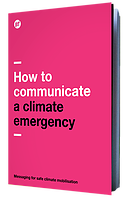How to communicate the climate emergency
 |
| Download guide as PDF |
What are effective ways of engaging people in conversation about the gathering climate crisis and the need for an emergency response? Let’s start with some key content:
1. Urgency and courage
The Earth is already too hot: we are in danger now, not just in the future. Warming will accelerate, and 1.5°C is only a decade away, yet annual emissions are still growing and the current, post-Paris emissions trajectory will result in catastrophic warming. The Great Barrier Reef and other coral systems are dying. We are greatly exceeding Earth’s limits, and food and water shortages are contributing to conflicts and forced migration.
On current trends, following the Paris Agreement, we may face catastrophic warming within our children’s lifetimes, with large parts of the world uninhabitable and major food growing regions ruined by drought (such as Australia’s Murray-Darling Basin, south-western USA) or rising seas (such as Vietnam, Bangladesh, Egypt). In past periods when greenhouse levels were similar to the current level, temperatures were 3–6°C higher and sea levels around 25–40 metres higher than in 1900.
Climate warming is an existential risk to human civilisation, and on the current warming path we are heading towards outright chaos.
The failure of community and political leaders to talk about such concerns leaves unspoken fears lurking just below the surface of public life, sapping our strength. Fear and alarm should be welcomed as healthy reactions that show we’ve noticed something dangerous is going on.
Our response to the climate crisis is the courage to match actions to the size of the problem.
2. Emergency response
Many people realise we are heading for a social and planetary crisis. Three-quarters of Australians consider climate change a “global catastrophic risk”.